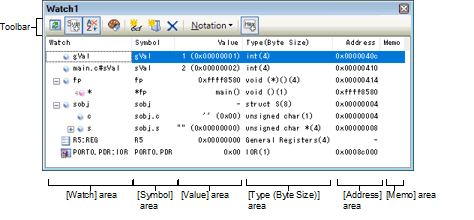2.11.5.1
Changing the form in which values are displayed
The form in which the data in the [Value] area are displayed can be freely changed using the toolbar buttons shown below.
|
Notation
|
Shows the following buttons that change the form in which values are displayed.
|
|
|
 AutoSelect
AutoSelect
|
Displays values on this panel in per-variable predetermined notation (default).
|
|
 Hexadecimal
Hexadecimal
|
Displays values on this panel in hexadecimal.
|
|
 Decimal
Decimal
|
Displays values on this panel in decimal.
|
|
 Octal
Octal
|
Displays values on this panel in octal.
|
|
 Binary
Binary
|
Displays values on this panel in binary.
|
|
 Decimal Notation for Array Index
Decimal Notation for Array Index
|
Displays array indexes on this panel in decimal (default).
|
|
 Hexadecimal Notation for Array Index
Hexadecimal Notation for Array Index
|
Displays array indexes on this panel in hexadecimal.
|
|
 Float
Float
|
Displays values on this panel in Float.
Except for 4-byte data or when values have type information, however, they are displayed in predetermined notation.
|
|
 Double
Double
|
Displays values on this panel in Double.
Except for 8-byte data or when values have type information, however, they are displayed in predetermined notation.
|
|

|
Adds a hexadecimal equivalent for the displayed value at the end of it, with the equivalent enclosed in parentheses ( ).
|
|
Encoding
|
Shows the following buttons that change the encoding in which string variables are displayed.
|
|
|
 ASCII
ASCII
|
Displays string variables in ASCII code (default).
|
|
 Shift_JIS
Shift_JIS
|
Displays string variables in Shift_JIS code.
|
|
 EUC-JP
EUC-JP
|
Displays string variables in EUC-JP code.
|
|
 UTF-8
UTF-8
|
Displays string variables in UTF-8 code.
|
|
 UTF-16 Big-Endian
UTF-16 Big-Endian
|
Displays string variables in UTF-16 Big-Endian code.
|
|
 UTF-16 Little-Endian
UTF-16 Little-Endian
|
Displays string variables in UTF-16 Little-Endian code.
|
|
 UTF-32 Big-Endian
UTF-32 Big-Endian
|
Displays string variables in UTF-32 Big-Endian code.
|
|
 UTF-32 Little-Endian
UTF-32 Little-Endian
|
Displays string variables in UTF-32 Little-Endian code.
|